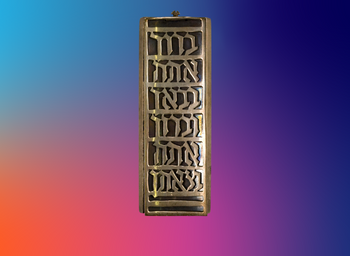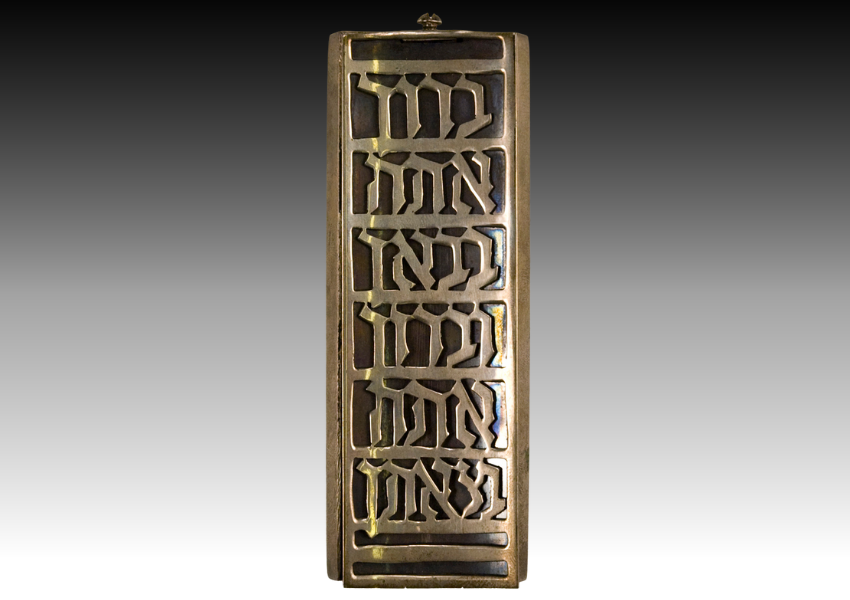A Mezuzah at the White House? Sounds Crazy
Published Dec 12, 2022

Mezuzah case inscribed in Hebrew after Deuteronomy 28:6, Ludwig Yehuda Wolpert

A mezuzah (Heb. מזוזה) is a place, and two or more objects, all at once. The place is the “doorposts of your house and on your gates,” where the words of the Shem‘a yisrael (“Hear, O Israel!”) are to be inscribed according to the Hebrew Bible (Deuteronomy 6:4-9; also check Deuteronomy 11:20). One object is the parchment on which the words of the Shem‘a itself (both verses mentioned above) are handwritten by a Hebrew scribe on 22 lines, while on the other side of the parchment the Hebrew term shaday (שדי, a direct reference to God, but also an acronym for shomer daltot yisrael, or “keeper of the doors of Israel”) is also inscribed. A second object is a cover, often made of cloth or metal, that protects the parchment if it is inserted in a niche carved in the doorpost, or a case, if instead the parchment, which is rolled up, is affixed outside the doorpost itself. The latter, the mezuzah case, is by far the most common way that Jewish communities the world over have found to fulfill the biblical commandment that is embedded with the object(s) themselves. A third object, as suggested by the custom of writing the word shaday, is the amulet that the mezuzah (doorpost, parchment, cover or case) embodies, as a form of protection, all the protection that homes and cities can get. Last, but not least, the very prominent and visible position of a mezuzah also makes it a clear, and strong, statement of identity.
This specific mezuzah case was made after a design by Ludwig Wolpert (Hildesheim, Germany, 1900 – New York City, USA, 1981). A designer, sculptor, and metal worker born in Germany to Lithuanian Jewish immigrants, Wolpert studied at the School of Applied Arts in Frankfurt before finding refuge in British-Mandate Palestine after the rise of the Nazis to power in 1933. There, he became a Professor and Director at the Bezalel Academy for Arts and Crafts in Jerusalem, before immigrating to the United States in 1956, following an invitation by the Jewish Museum in New York to lead the Tobe Pascher Workshop. Among his works is a Torah case presented to President Harry S. Truman by Israel’s President Chaim Weizmann, as well as the Jewish section of the Cadet Chapel at the U.S. Air Force Academy in Colorado Springs, and the entrance to the Jewish Chapel at John F. Kennedy Airport.
I chose this object because, beginning in 2021, I worked with the Staff of the White House to select a mezuzah case that would be affixed on an entrance to the official residence of the Vice-President of the United States, in Washington DC—the United States Naval Observatory at Number One Observatory Circle—and this is the one that emerged from the selection process. (A few others were also considered, all at my suggestion).
The request to find a mezuzah for this building came as a way to mark the fact that the Second Gentleman of the United States, Doug Hemhoff, is the first Jewish spouse of either a President or a Vice President in the history of the US. Selecting such an object is both a professional and cultural responsibility from which many questions can arise. On the professional (curatorial) side: What object can be suitable for display in such a prominent venue? What museum object can be displayed in a non-museum setting? And on the cultural side of the same equation: What does it mean to affix a mezuzah in a Government building? What is the status of Jewish ritual objects, within and outside the museum?
In the end, I helped with selecting an object that has ritual value and historical value, and, also, an object that is a bit of an outlier: an art object designed in an exclusive museum setting, but with a popular aim; and a Jewish ritual object that not only embodies a history of migration (not uncommon in the landscape of Jewish culture), but that also one that reflects the individual histories of women in public service and in contact with major historical events (a much less common occurrence as far as Jewish ritual objects are usually concerned).
Physically produced—likely in New York (but also, possibly, in Portugal)—in the early 1970s, as Ludwig Wolpert’s designs of Jewish ritual objects had been earmarked for larger-scale production, the case was acquired by the late Leah Rabin (1928-2000), who donated it to Alice Grossman in 1974. That year, Leah Rabin’s husband, Yitzhak Rabin (1922-1995) succeeded Golda Meir as Prime Minister of the State of Israel. Ms. Grossman (1909-2007), herself an immigrant to the United States and a veteran of the Women’s Army Corps in World War II, had been Mr. Rabin’s English-language secretary during his tenure as Israel’s Ambassador to the United States (1968-1973), and had become a friend of the family. The relationship between Alice Grossman and the Rabin family is documented in letters and photographs that were donated to The Magnes in 2008.
Above:
Mezuzah case inscribed in Hebrew after Deuteronomy 28:6 (“Blessed shall you be in your comings and blessed shall you be in your goings”)
After a design by Ludwig Yehuda Wolpert (1900-1981)
[New York, United States, or Portugal], ca. 1970 (designed in Jerusalem, 1939)
Medium: Sterling silver (hand-worked)
Dimensions: 4-⅜” (h) x 1-⅝” (w) x ⅜” (d)
The Magnes Collection of Jewish Art and Life, University of California, Berkeley, Gift of Molly Grossman, 2008.23.1 a-d
Francesco Spagnolo is the Curator of The Magnes Collection of Jewish Art and Life and an Associate Adjunct Professor in the Department of Music at the University of California, Berkeley. A multidisciplinary scholar focusing on Jewish studies, music, and digital media, he intersects textual, visual, and musical cultur...
Reflections
For those with a mezuzah hanging on their (or their neighbor's) doors:
What is the story of the object that you see (and, maybe, touch) every day? Where did it come from? What stories are embodied in it?
For museum-goers:
What are the "politics" of museum display? What gets displayed, and what does not? And why? And what happens to a museum object if it is displayed outside of the museum collection it "belongs" to?
For anyone asking questions about the relationship between religion and State:
How do you feel about a religious object being displayed in a public building? (Please, discuss…).*
*Francesco Spagnolo shared his thoughts here.
Want more?
Get curated JewishArts.org content in your inbox


